Sunita’s Space Odyssey
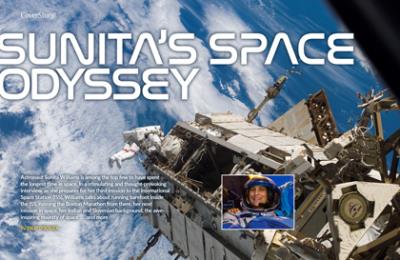
Astronaut Sunita Williams is one of the handful of humans to have been in outer space. With a total of 322 days in space across two expeditions to the International Space Station, she is among the leaders for time spent up there. In a stimulating and thought-provoking interview, as she prepares for her third mission to the International Space Station (ISS), Williams talks about running barefoot inside the ISS, running the Boston Marathon from there, her next mission in space, her Indian and Slovenian background, the awe inspiring majesty of space . . . and more.
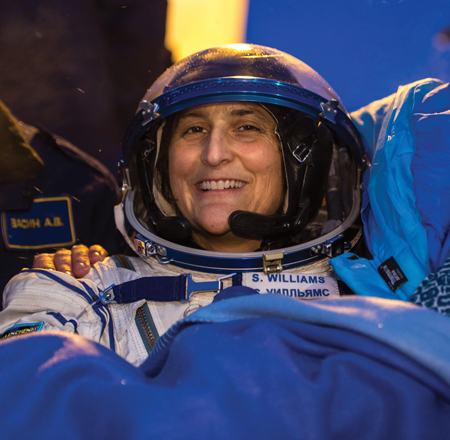
“I just lost some really good friends,” thought Sunita Williams, “and I don’t know if we’ll ever get to fly in space again.” This was after the Columbia Space Shuttle disaster of 2003 which killed all seven astronauts on board. One of them was Williams’ good friend, Kalpana Chawla.
Only months later, Williams was assigned to her first space flight. But far from being deterred by the tragedy, she looked at it this way: “I’m doing whatever I can to help this program move forward. And that’s okay.”
It’s a small but telling statement that paints a picture of a woman of uncommon substance.
Born in September 1965 to a Slovenian mother and an Indian father, Williams grew up in Massachusetts and studied at the United States Naval Academy and the Florida Institute of Technology. As a naval aviator, she flew helicopters over Iraq in the run-up to the Persian Gulf War. After 11 years in the U.S. Navy, she joined NASA in 1998 to train to be an astronaut. Eight years later, she made her first trip to space.
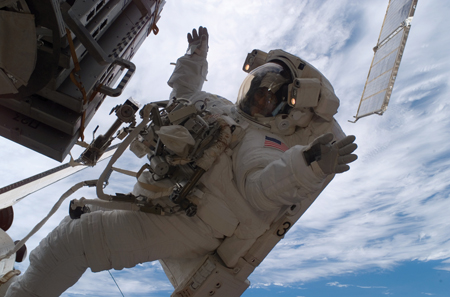
[Left] Sunita Williams in a session of extravehicular activity (EVA) on the International Space Station (ISS). (Photo: NASA)
In 2015, NASA assigned her to their commercial spaceflights program to explore collaborations in space with commercial partners. “We contracted with SpaceX and Boeing to take people to the International Space Station,” she says. “I was working with both teams until 2018, and then exclusively with Boeing. I’m going to be on the first flight of the Boeing Starliner going to the International Space Station.” That flight is scheduled for April of this year. “We’re getting there,” says Williams. “We’ll fly when we’re ready!”
Following are excerpts from our wide-ranging conversation with Sunita Williams over a zoom call.
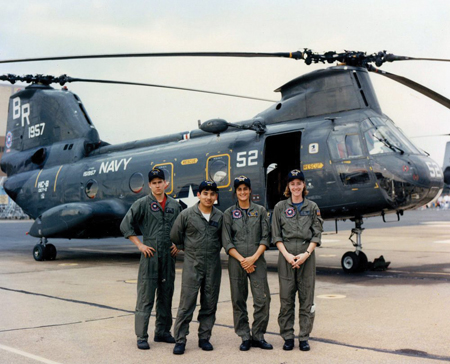
[Right] “Being part of something bigger than yourself resonated with me,” says Williams about her time in the military as a naval aviator. (Photo courtesy: Sunita Williams)
Dilip D’Souza: There’s a little story I want to tell you. I get an alert from NASA whenever the International Space Station goes overhead across the area that I am in. So, I go to this promenade near the sea in Mumbai where every evening, hundreds of people are walking up and down. When the Space Station appears on the horizon as a point of light, I point at it and say “Sunita Williams! You can see her waving!” Maybe two-thirds of the people look up with me and marvel at the sight. One-third look straight down and continue walking, refusing to look up probably because they think I’m a madman. Not even mentioning your name tempts them!
Sunita Williams: But thank you, thank you for trying to get folks interested in this! I mean, I think the things that we do are really for humanity.
Somewhere at the back of my mind, I’ve always wanted to tell Sunita Williams that story. I had never imagined I would.
In a real sense, her reaction to it was colored by the perspective she has on our world as she views it from the International Space Station. Up there, she must start looking beyond boundaries in the mind and on the ground and start thinking of humanity as a whole. And then, yes, space exploration is really not just for the U.S.A. or India. It’s for all of humanity.
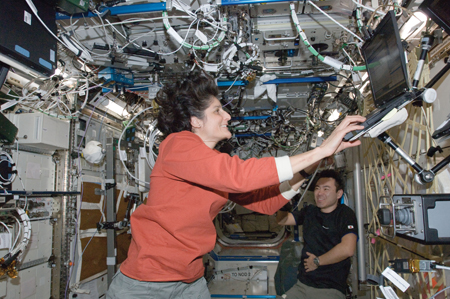
As a child, were you always interested in space and becoming an astronaut, or did that come to you later?
That came as I grew older. I was very lucky to grow up in a wonderfully diverse family. My father immigrated from India. He was a scientist and a doctor. My mother’s side of the family came over to the United States years earlier, but from Slovenia and had a pretty thick Slovenian background. My older brother and sister are overachievers. I think it was in our nature to do the best that we could do.
[Top] Using a laptop on the ISS. Japanese astronaut and flight engineer Aki Hoshide is behind Williams. (Photo: NASA)
I didn’t think about being an astronaut. I thought about doing what my dad did—being a doctor—but I loved animals. I got that from my mom. So, of course, I wanted to be a veterinarian when I was a child.
But in the meantime, my brother, who was pretty adventurous, had joined the Navy. He suggested that the Naval Academy would be a good place for me too. At his recommendation, I applied and got in. That opened the door for me to be a test pilot.
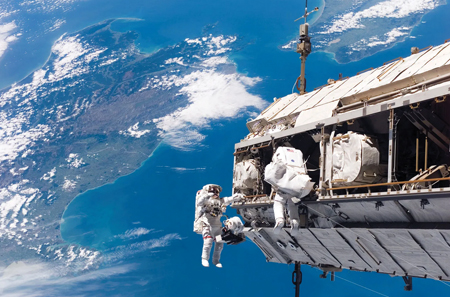
[Top] The International Space Station (ISS) is the largest modular space station orbiting about 250 miles above the earth. Between two expeditions to the ISS (2007 and 2012), Williams clocked 322 days there as an astronaut and flight engineer. (Photo: NASA)
Were you just looking at a military career or were you also thinking of being an astronaut?
Oh, really, just a military career. I learned how to be a scuba diver. I learned to fly helicopters as well as airplanes, and I was having a lot of fun. But I didn’t know if that was really for the rest of my life. I loved the people, the leadership, and the followership opportunities. Being part of something bigger than yourself resonated with me. I toyed with the thought of leaving and starting a family, but I still yearned for this bigger team thing. That seemed to fall into place when I applied and got into NASA. It’s a big team. We do a lot of big things, but only because it’s a team.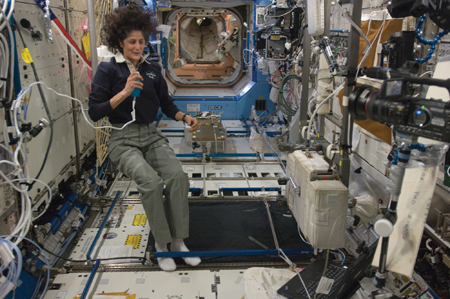
You used the word “followership.” What do you mean by that and why does that mean some-thing to you?
Because every team can’t have a ton of leaders. Then nobody’s actually getting work done. So being a positive follower . . . the one that says, “let me pick this up,” “let me make breakfast for people in the morning.” Maybe you’re not making all the strategy, you’re trying to just be an additive member of that team.
[Right] Williams in the Destiny Laboratory of the ISS. (Photo: NASA/ Johnson)
It’s a big thing that we talk about and learn here at NASA. You have to take care of yourself, make sure you can do the tasks that are requested of you, work out whatever you have to do so that you are a good team member, and then make that team do better. Eventually, more than likely, you’ll have some role as a leader. But being part of the team is actually the biggest key.
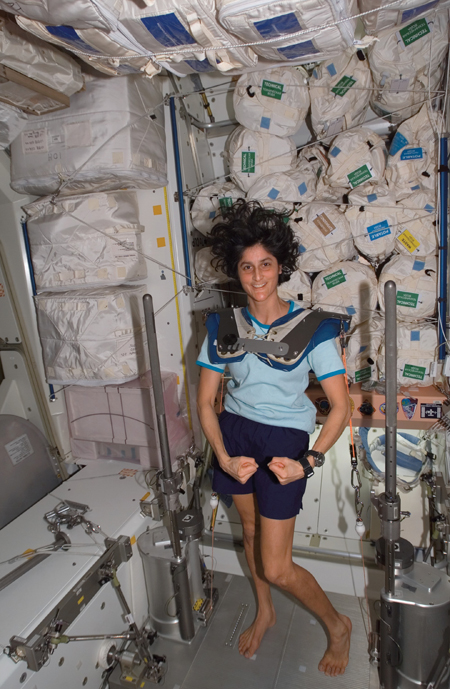
Give us an idea of what it was like to have spent so long at the International Space Station.
I was going to the space station with a space shuttle crew. They all knew that they were going to come up and go back down and [then] it sort of clicked: “Whoa! I’m like them, but not like them. I’m going up with them, but they’re leaving me.” So, I found myself, two months beforehand, making sure I went and saw all my friends and family, that I was at peace in my mind with the people in my life as well as the animals—just told them I love them. That allowed me to focus on getting ready to go to space.
[Left] Posing for a photo while using the Interim Resistive Exercise Device (IRED) equipment in the Unity node of the ISS. (Photo: NASA/ Johnson)
Were the Challenger (1986) and Columbia (2003) disasters on your mind?
Oh absolutely! Kalpana Chawla and I were friends since as soon as I got here. We had, obviously, things in common, Indian food being number one. Columbia happened about three months after I was assigned to my first spaceflight and I thought, “Wow, I just lost some really good friends. I don’t know if we’ll ever get to fly in space again.” There was a long investigation, took about two years. But I thought, “I’m doing whatever I can to help this program move forward. And that’s okay.”

Tell me a little bit about the physical aspect of it all. Your first time in the ISS lasted 192 days! What did that do to you? Did you notice your body reacting differently in any way?
Yeah, you do go through some changes. Initially, people moving in space are sort of clumsy and fly around fast and push off things. You slow down as time goes on. Because you know if you give a push, you’re going to fly all the way across the room. So, everything calms down and you become really good at flying in space. To the point where you could fly down the hallway and then click a toe on a handrail, stop yourself, and then do something with your hands. You don’t even have to use your hands. Your toes become like a little bit of a holder for you.
[Right] In a Partial Gravity Simulator (POGO) training session at the Space Vehicle Mockup Facility (SVMF). (Photo: NASA/James Blair)
But with that come some downsides. In space, if you don’t exercise, your bone density would go away and your muscle mass would decrease. Some folks have had vision changes because of the intraocular pressure from a fluid shift. Your spine expands and so your back hurts a little bit. You lose the calluses on the bottom of your feet and they become soft.
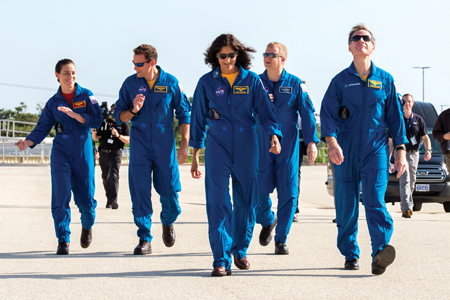
[Top] The crew of Boeing’s CST-100 Starliner. Williams and astronaut Josh Aaron Cassada have been assigned to Boeing’s first operational mission to the ISS. (Photo: Boeing/Eric Shindelbower)
How do you combat declining bone density?
Here on Earth, we walk around and our bone density gets rejuvenated with that pounding. But since that [walking] doesn’t happen in space, the objective is to put stress on your bones. In particular, hips and feet and legs. On my first space flight, we had the Interim Resistive Exercise Device (IRED) where you can do squats or deadlifts with a weight on your shoulders and on your hips. During my second space flight, we had the Advanced Resistive Exercise Device (ARED), a platform that floats and has a bar [where] you can pull 300 or 600 pounds. So that way you can put the bar on your back and do squats, deadlifts, arm curls, or sit-ups. That helps regenerate bone density. In addition, there’s the treadmill. When you’re on it, that constant pounding works on the bone density and your ankles, your feet, and your hips.
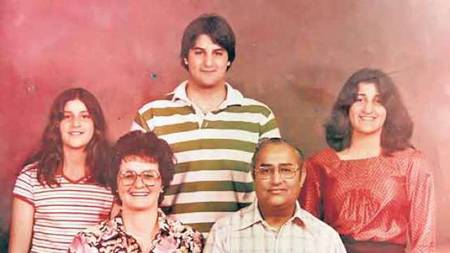
[Top] A snapshot from the past: Williams, with her siblings and parents, a Slovenian mother and an Indian (Gujarati) father. (Photo courtesy: Sunita Williams)
Also makes the bottom of your feet a little less soft?
Yeah, it does, actually. But we have tennis shoes up there, so we work out with them on. But Shannon Lucid, who had been up on the Mir Station for about six months, once told me: “Your feet are gonna be really soft when you get back.” So, I was like, “Aha! Maybe I will run without any shoes on. That would really get the bottom of my feet stimulated.” So, there’s a couple of pictures of me floating around barefoot.
You also famously ran the Boston Marathon when you were up there. How did that happen? Were you on a treadmill?
Yeah, I was on the treadmill. I had done a qualifying time for the Marathon so that I could run it. But I knew that I was going to space and so would miss it. My sister went to the race director and actually got permission for me to run it in space and they sent me a number. My sister ran it on the ground while I ran it in space and we had about the same time—4:20 [hours] or something like that. But the motivation was: one, I had qualified so I wanted to run. But secondly, I figured this was my one platform to talk to the kids on Earth and say, “Physical fitness is important. It’s important even when you’re flying in space, even when you’re an astronaut.”
What about spacewalking? Was that different? Because you’re essentially just tethered to a string, and you could suddenly be gone.
No! I think the reason is that I like technical things and working with my hands, and I want to make sure things are done correctly. I’m not always perfect at it, but there’s a lot in your control when you’re doing a spacewalk and you need to make sure that it is absolutely done correctly.
One of the biggest things you’re thinking about on a spacewalk is, “Where’s my buddy? Where’s the other guy? And does the other guy know where I am? In case anything happens, I will need to go get that guy and that guy will need to come get me.” On my first flight, I was spacewalker number two and I thought about my tasks. On my second flight, I was spacewalker number one and it was about making sure of everybody’s safety, making sure we knew when to call it quits. We all knew each other’s limitations. When you’re doing something very technical like that, in a dangerous environment, you really need to have all of those things in your hip-pocket so that you know how to execute the mission correctly.
So, I didn’t feel like I would just float away. We are trained to really make sure you’re proficient with the equipment and can really focus on your tasks [even while focusing] on the big picture of making sure everybody gets in the door.
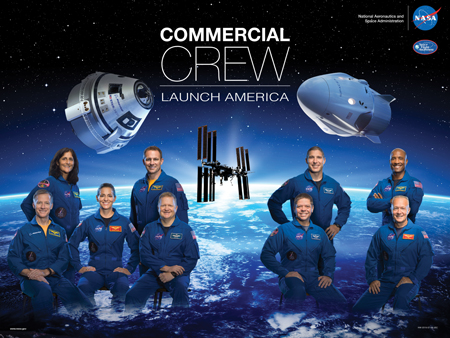
[Top] Williams is currently training for her first-ever commercial space flight in collaboration with SpaceX and Boeing.
Something else that I wonder about is that on long flights—going to Mars or further—a few of you will be stuck in this tin can for months. So, what does that do to you as human beings?
We talked about it on my last flight. We were in one module having dinner, and it was about the size of the Orion capsule that went to the moon. And we thought: what would it be like for the three of us to be sitting in there the whole time?
With any small team, everybody needs responsibility for something. Everybody has to feel useful. Everybody has to feel like they’re contributing. So that’s one way: make each person an expert on a different thing. That might be the guy who’s in charge of the maintenance of the spacecraft. That might be the guy who’s in charge of the food. That might be the guy who’s plotting the route. That might be the guy who’s communicating to the ground. All those different tasks. I think that’s one way to make sure that folks don’t get on each other’s nerves. Everybody’s not trying to do the same thing.
I think Star Trek did it really well where they had all those different people from different backgrounds and everybody had a different job. You know: Bones the engineer, Sulu, Uhura... Pretty wise, how they set that show up.
So, is this something that NASA and the astronauts are aware of—the possibility of these kinds of issues on long spaceflights?
Yeah, we prepare for it, actually. There are discussions and reflections on expeditions, like the Shackleton expedition to the South Pole. Then we even participate in a thing called National Outdoor Leadership School (NOLS). We take our potential crew members into a place where it’s a little bit uncomfortable—camping, hiking, kayaking in cold or rainy or hot and dry weather. You get to a point where everybody is a little bit stressed. And you can see how you interact with others when you’re not in your comfort zone. Then they teach some techniques for self-care and team care and being part of the team. All of us astronaut candidates and crew members actually go for a NOLS course. Plus there are discussions on leadership and followership and teamwork.
You mentioned the Orion spacecraft that went around the moon. How do you view the Artemis mission? Are you going to be part of it?
I would love to be part of it! But I’ve been in the office for quite some time, and we have some really great younger astronauts and I’m really excited to see them go fly. If they said, “Suni, go do it,” absolutely, without a doubt I’d go. But I have been lucky enough to be part of the International Space Station, part of the Space Shuttle Program. Also, [there is] this commercial crew role that I am in right now—which is [about] getting international commercial partners moving toward their own ability to fly spacecrafts.
But Artemis is really cool. It’s like the seed, right? The first Orion shows that we have the technology to go to the Moon. Then the next one, with people on board. And then the third one, when we land on the moon. We want to land closer to the South Pole and have a sustainable presence on the moon. Maybe build a space station and practice for when we actually go on to Mars.
The Apollo program was much simpler than the Artemis program. It put boots on the moon and then we were done. It was a technology demonstration. It wasn’t a sustainable presence. The Artemis program opens up so many more opportunities.
What do you make of India’s space effort, Indian Space Research Organization (ISRO), in comparison to NASA? Is there a lot of interaction between the two agencies and are you part of that at all?
I am not, unfortunately. At the very beginning of my career at NASA, we weren’t really allowed to talk too much to ISRO. But I am so happy that now we have an International Astronautical Congress, and there’re people there from ISRO. I know that they are thinking of a manned space program. [So, some of the questions that they may be considering could be] how do you plan for that? And what kind of things should you consider?
So, I’m really excited. I mean, everybody should try it, right? Everyone should put their efforts into space exploration because it’s for good. We’d like to be the leaders in space, but it doesn’t mean we don’t want others in space. We want people from everywhere in space, people who are going to be taking care of humanity. I absolutely feel India is right up there helping out with that.
We’re proud of how a lot of ISRO’s scientists are women. There’s this famous photograph from when Mangalyaan went to Mars and all these ISRO women scientists on the ground were celebrating! Quite something. I went to an engineering college where there were 20 girls in a class of 400. So, it’s really a tectonic shift!
It’s great! You know, little girls ask me, “Oh, are you worried about having that job?” And I say, in all honesty, “The helicopter didn’t know if I was a girl or a boy. The spacesuit didn’t know, the spacecraft didn’t know!” No, I wasn’t worried. I had a job to do, and I just went and did it.
You mentioned your parents a few times. Are you conscious of your Slovenian and Indian heritages?
Oh, of course! I’ve mentioned the food. I am not one to eat boring food! And there’s cultural richness, there’s family associated with that. And I think I felt all that growing up, with both sides of the family. I cherish that. That household was multisided, multifaceted; friends from all over the world would come over.
I’ve had the luxury of going to both India and Slovenia and meeting people there. All those traditions that my family had for Christmas or Diwali—you feel them: the values and traditions that I was lucky to grow up with. People ask, “what is your impression of India?” It’s colorful! I mean, the food is one thing, but it’s just colorful.
My impression of Slovenia? Very outdoorsy. There people like hiking in the mountains, running, and skiing. Obviously, along with that comes good food. Very hearty food in Slovenia, but very spicy food in India.
I think that epitomizes my brother and my sister and myself. We’re very athletic like I mentioned, but very colorful and open-minded—which is what I get from India—and, I think, very loving. Slovenian people are so nice. They’re genuinely nice and loving and caring. I feel that in India too.
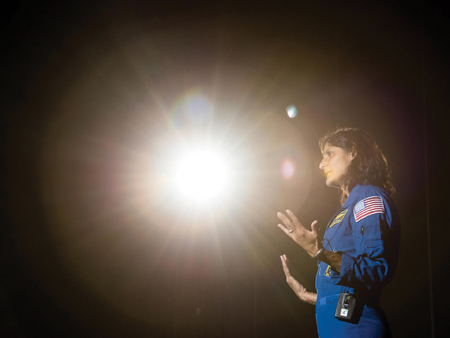
When you are out there—orbiting miles away from the earth in vast, endless space—are you conscious of the whole profundity of space? And does that trigger thoughts about God or creation or spirituality?
On a daily basis, no.
But I was on a spacewalk once with the northern lights below me. It really hit home then that there’s so much more in the universe that we can’t even tap into. So much energy, so much power, so many other things. We are just this tiny little planet. And we have a lot going on, of course, on our planet. But maybe our focus on our planet should be a little more toward helping each other out. And so, you stop—you can’t help yourself—you look down and it’s bigger than anything else, anything we can do.
I’m not overly religious, I think I’m a little bit more spiritual. I think my time in space has showed me how privileged and lucky we are as human beings to be living on such an amazing planet. There’re tons of stars, probably other planets out there that have human beings, but it’s too hard for us to find them. Right now, this is our rock; and our rock is not just a rock! It actually has clouds and an ocean, things are moving. It’s very dramatic—like it’s alive itself.
When you look down at the planet, you can’t help but think to yourself, “This world that we live in is pretty amazing.” So how did it all happen? I think those are the mysteries that I thought about. There’s got to be some bigger being out there that’s taking care of us..
Dilip D’Souza is a widely published veteran journalist who writes extensively on math and science, making these subjects interesting and accessible by adding a component of wonder. All this naturally leads to space and space exploration being topics for D’Souza’s regular columns. He has a Master’s in Computer Science from Brown University, has lived in Providence and Texas for ten years, and has made Mumbai his home since 1992.
Enjoyed reading Khabar magazine? Subscribe to Khabar and get a full digital copy of this Indian-American community magazine.
blog comments powered by Disqus










